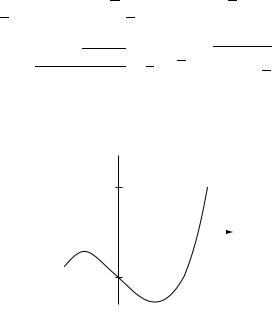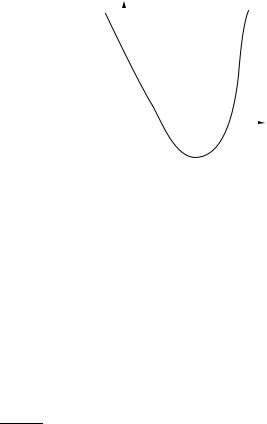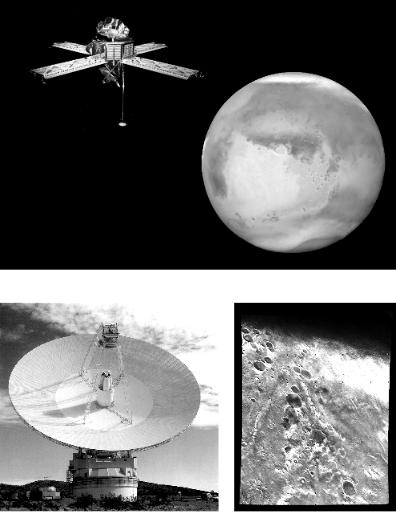
- •List of Symbols
- •Classical Algebra
- •Modern Algebra
- •Binary Operations
- •Algebraic Structures
- •Extending Number Systems
- •Algebra of Sets
- •Number of Elements in a Set
- •Boolean Algebras
- •Propositional Logic
- •Switching Circuits
- •Divisors
- •Posets and Lattices
- •Normal Forms and Simplification of Circuits
- •Transistor Gates
- •Representation Theorem
- •Exercises
- •Groups and Symmetries
- •Subgroups
- •Cyclic Groups and Dihedral Groups
- •Morphisms
- •Permutation Groups
- •Even and Odd Permutations
- •Equivalence Relations
- •Normal Subgroups and Quotient Groups
- •Morphism Theorem
- •Direct Products
- •Groups of Low Order
- •Action of a Group on a Set
- •Exercises
- •Translations and the Euclidean Group
- •Matrix Groups
- •Finite Groups in Two Dimensions
- •Proper Rotations of Regular Solids
- •Finite Rotation Groups in Three Dimensions
- •Necklace Problems
- •Coloring Polyhedra
- •Counting Switching Circuits
- •Exercises
- •Monoids and Semigroups
- •Finite-State Machines
- •Quotient Monoids and the Monoid of a Machine
- •Exercises
- •Rings
- •Integral Domains and Fields
- •Subrings and Morphisms of Rings
- •New Rings From Old
- •Field of Fractions
- •Convolution Fractions
- •Exercises
- •Euclidean Rings
- •Euclidean Algorithm
- •Unique Factorization
- •Factoring Real and Complex Polynomials
- •Factoring Rational and Integral Polynomials
- •Factoring Polynomials over Finite Fields
- •Linear Congruences and the Chinese Remainder Theorem
- •Exercises
- •Ideals and Quotient Rings
- •Computations in Quotient Rings
- •Morphism Theorem
- •Quotient Polynomial Rings that are Fields
- •Exercises
- •Field Extensions
- •Algebraic Numbers
- •Galois Fields
- •Primitive Elements
- •Exercises
- •Latin Squares
- •Orthogonal Latin Squares
- •Finite Geometries
- •Magic Squares
- •Exercises
- •Constructible Numbers
- •Duplicating a Cube
- •Trisecting an Angle
- •Squaring the Circle
- •Constructing Regular Polygons
- •Nonconstructible Number of Degree 4
- •Exercises
- •The Coding Problem
- •Simple Codes
- •Polynomial Representation
- •Matrix Representation
- •Error Correcting and Decoding
- •BCH Codes
- •Exercises
- •Induction
- •Divisors
- •Prime Factorization
- •Proofs in Mathematics
- •Modern Algebra in General
- •History of Modern Algebra
- •Connections to Computer Science and Combinatorics
- •Groups and Symmetry
- •Rings and Fields
- •Convolution Fractions
- •Latin Squares
- •Geometrical Constructions
- •Coding Theory
- •Chapter 2
- •Chapter 3
- •Chapter 4
- •Chapter 5
- •Chapter 6
- •Chapter 7
- •Chapter 8
- •Chapter 9
- •Chapter 10
- •Chapter 11
- •Chapter 12
- •Chapter 13
- •Chapter 14
- •Index

260 13 GEOMETRICAL CONSTRUCTIONS
number cos(2π/n). The Greeks knew how to construct regular polygons with three, four, five, and six sides, but were unable to construct a regular 7-gon.
It is well known how to construct an equilateral triangle and a square using straightedge√ and compass. We proved in Example 11.15 that cos(2π/5) = ( 5 − 1)/4; thus a regular pentagon can be constructed. Furthermore, if a regular n-gon is constructible, so is a regular 2n-gon, because angles can be bisected using straightedge and compass. Proposition 13.13 shows that π/9 cannot be constructed; hence 2π/9 and a regular 9-gon cannot be constructed.
In 1796, at the age of 19, Gauss discovered that a regular 17-gon could be constructed and later showed the only regular n-gons that are constructible are the
ones for which2m |
= 2 |
k |
· · · pr , where k 0 and p1, |
2m |
|
r are distinct primes |
p1 |
|
|||||
n |
+ 1. Prime numbers of the form 2 |
. . . , p |
|
|||
of the form 2 |
|
+ 1 are called Fermat |
||||
primes. Pierre de Fermat (1601–1665) conjectured that all numbers of the form 22m + 1 are prime. When m = 0, 1, 2, 3, and 4, the numbers are 3, 5, 17, 257, and 65,537, respectively, and they are all prime. However, in 1732, Euler discovered that 225 + 1 is divisible by 641. Computers have checked many of these numbers for m > 5, and they have all been composite. In fact, no more Fermat primes are known today.
A complete proof of Gauss’s result is beyond the scope of this book, since it requires more group and field theory than we have covered (see Stewart [35]). However, we can prove the following.
Theorem 13.16. If p is a prime for which a regular p-gon is constructible, then p is a Fermat prime.
Proof. Let ξp = cos(2π/p) + i sin(2π/p), a pth root of unity. If a regular p-gon can be constructed, cos(2π/p) and sin(2π/p) are constructible numbers and [Q(cos(2π/p), sin(2π/p)) : Q] = 2r for some integer r. Hence
[Q(cos(2π/p), sin(2π/p), i) : Q] = 2r+1.
Now Q(ξp ) Q(cos(2π/p), sin(2π/p), i) and so, by Theorem 11.6,
[Q(ξp ) : Q] = 2k for some integer k r + 1.
The pth root of unity, ξp , is a root of the cyclotomic polynomial φ(x) =
xp−1 |
|
+ |
xp−2 |
+ · · · + |
x |
+ |
|
|
|
|
k |
|
|
|
|
|
|
|
|
|
|||||
|
|
|
|
|
|
|
1 which, by Example 9.31, is irreducible over Q. Hence |
||||||||||||||||||
[Q(ξp ) : Q] = p − 1, kand therefore p − 1 = 2 . |
|
|
k |
|
|
|
of 2. Suppose |
||||||||||||||||||
The number p |
= |
2 |
+ 1 is a prime only if |
k |
= 0 or |
|
|
|
|||||||||||||||||
that |
|
|
|
|
|
|
|
|
|
|
|
|
is a power a |
|
|||||||||||
|
k contains an |
odd factor |
b > 1 and that k |
= |
a |
· |
b. Then |
2 |
+ 1 divides |
||||||||||||||||
a |
b |
+ 1, since x + 1 divides x |
b |
|
|
|
|
|
|
ab |
|
|
|||||||||||||
(2 ) |
|
|
|
+ 1 if b is odd. Hence 2 |
|
+ 1 cannot be prime. |
|||||||||||||||||||
The |
case p |
= |
2 gives rise to the degenerate 2-gon. Otherwise, p is a Fermat |
||||||||||||||||||||||
2m |
|
|
|
|
|
|
|
|
|
|
|
|
|
|
|
|
|
|
|
|
|||||
prime, 2 |
+ 1, for some integer m 0. |
|
|
|
|
|
|
|
|
|
|
||||||||||||||
NONCONSTRUCTIBLE NUMBER OF DEGREE 4
This next example shows that Corollary 13.6 does not give a sufficient condition for a number to be constructible.

NONCONSTRUCTIBLE NUMBER OF DEGREE 4 |
261 |
Example 13.17. There is a real root ri , of the irreducible polynomial x4 − 4x + 2, that is not constructible, even though [Q(ri ) : Q] = 22.
Solution. By Eisenstein’s criterion, x4 − 4x + 2 is irreducible over Q, so that [Q(ri ) : Q] = 4 for each root ri . However, we can factor this polynomial into two quadratics over R, say
x4 − 4x + 2 = (x2 + ax + b)(x2 + cx + d).
Comparing coefficients, and then using equation (i), we have
(i) |
0 |
= a + c |
and |
c = −a |
(ii) |
0 |
= b + d + ac |
and |
b + d = a2 |
(iii) |
−4 |
= bc + ad |
and |
− 4 = a(d − b) |
(iv)2 = bd.
Let t = b + d, so that 16 = a2{(b + d)2 − 4bd} = t (t2 − 8). This number t satisfies the equation
(v) t3 − 8t − 16 = 0.
By Theorem 9.25, this equation (v) has no rational roots; thus t3 − 8t − 16 is irreducible over Q. We see from Figure 13.7 that the equation does have a real root ρ between 3 and 4, and the coefficients a, b, c, d can be expressed in terms of ρ.
Either a or c is positive. Without loss of generality suppose that c > 0; thus |
||||||
b + d = t = ρ, a = −c = −√ρ, and d − b = 4/√ρ. Therefore, we have b = |
||||||
ρ/2 − 2/√ρ and d = ρ/2 + 2/√ρ, and the roots of x2 + ax + b are |
||||||
−a ± √a2 − 4b |
1 √ρ |
|
− |
ρ |
8 |
, |
2 |
= 2 |
± |
|
+ √ρ |
|
|
which are real, since ρ < 4. These are the roots r1 and r2 in Figure 13.8.
 t 3 − 8t − 16
t 3 − 8t − 16
16
|
|
|
|
|
|
|
|
|
|
r |
|||
|
|
|
|
|
|
|
|
|
|
|
|
|
|
−2 |
0 |
2 |
|
4 t = b + d |
|||||||||
−16
Figure 13.7. Graph of t3 − 8t − 16.

262 |
|
|
|
|
13 |
GEOMETRICAL CONSTRUCTIONS |
|||
3 |
|
|
x 4 − 4x + 2 |
|
|
||||
|
|
|
|||||||
|
|
|
|
|
|
|
|
||
2 |
|
|
|
|
|
|
|
|
|
|
|
|
|
|
|
|
|
||
1 |
|
|
|
|
|
|
|
|
|
|
|
|
|
|
|
|
|
||
|
|
|
|
|
|
|
|
|
|
0 |
|
r1 |
1 |
r2 x |
|||||
|
−1 |
|
|
|
Graph of x4 − 4x + 2. |
||||
Figure 13.8. |
|||||||||
If both these roots of x4 − 4x + 2 are constructible, then (r1 + r2)2 = ρ is also constructible. But this is impossible, since ρ is a root of the irreducible
polynomial |
4t3 − 8t − 16 and [Q(ρ) : Q] = 3. |
|
Hence x |
− 4x + 2 has a real root that is not constructible. |
This example was adapted from the article by Kalmanson [42].
EXERCISES
For Exercises 13.1 to 13.6, which of the numbers are constructible?
|
|
2 |
|
|
|
|
|
|
|
√ |
3 |
|||
13.1. |
|
5 + √2. |
6 |
|
|
|
|
|
||||||
4 |
13.2. √2. |
|
|
|
||||||||||
13.3. |
|
|
√ |
|
. |
|
13.4. (1 − 4 |
|
) . |
|||||
1 + |
|
7 |
||||||||||||
|
5 |
|
7 |
|
|
|
|
|
|
|
|
|
||
13.5. |
|
|
|
|
|
13.6. 3 7 − 5√2. |
||||||||
1 − |
√27. |
|||||||||||||
13.7.Is Q(cos φ) = Q(sin φ) for every angle φ?
13.8.If tan φ is constructible, show how to construct the angle φ.
13.9.Prove that all the constructible numbers are algebraic over Q.
For the values of cos φ can trisect the angle φ
given in Exercises 13.10 to 13.13, determine whether you by straightedge and compass.
13.10. |
cos φ = 1/4. |
13.11. |
cos φ = |
−9/16. |
||||
13.12. |
cos φ = 1/√ |
|
|
13.13. |
cos φ = |
√ |
|
/8. |
2. |
2 |
|||||||
13.14.By writing π/15 in terms of π/5 and π/3, show that it is possible to trisect π/5 and also possible to construct a regular 15-gon.
13.15.Can π/7 be trisected?
13.16.Construct a regular pentagon using straightedge and compass only.
13.17.Prove that cos(2π/7) is a root of 8x3 + 4x2 − 4x − 1 and that 2 cos(2π/7) is a root of x3 + x2 − 2x − 1. Hence show that a regular septagon is not constructible.
EXERCISES |
263 |
13.18. If the regular n-gon is constructible and n = qr, show that the regular q-gon is also constructible.
13.19. Let ξ = cos(2π/p2) + i sin(2π/p2). Show that ξ is a root of f (x) = 1 + xp + x2p + · · · + x(p−1)p .
Prove that f (x) is irreducible over Q by applying Eisenstein’s criterion to f (1 + x).
13.20.Using Exercises 13.18 and 13.19, prove that if a regular n-gon is constructible, then n = 2k p1 · · · pr where p1, . . . , pr are distinct Fermat primes.
13.21.Prove that a regular 17-gon is constructible.
For Exercises 13.22 to 13.33, can you construct a root of the polynomials?
13.22. |
x2 |
− 7x − 13. |
13.23. |
x4 − 5. |
||
13.24. |
x8 |
− 16. |
13.25. |
x3 |
− 10x2 + 2. |
|
13.26. |
x4 |
+ x3 |
− 12x2 + 7x − 1. |
13.27. |
x5 |
− 9x3 + 3. |
13.28. |
x6 |
+ x3 |
− 1. |
13.29. |
3x6 − 8x4 + 1. |
|
13.30. |
4x4 − x2 + 2x + 1. |
13.31. |
x4 |
+ x − 1. |
||
13.32. |
x48 − 1. |
|
13.33. |
x4 |
− 4x3 + 4x2 − 2. |
|

14
ERROR-CORRECTING CODES
With the increased use of electronic instrumentation and computers, there is a growing need for methods of transmitting information quickly and accurately over radio and telephone lines and to and from digital storage devices. In fact, CDs and DVDs use error-correcting codes.
Over any transmission line, there is liable to be noise, that is, extraneous signals that can alter the transmitted information. This is not very noticeable in listening to the radio or even in reading a telegram, because normal English is about 20% redundant. However, in transmissions from satellites and in computer link-ups, the redundancy is usually zero; thus we would like to detect, and possibly correct, any errors in the transmitted message. We can do this by putting the message into a code that will detect and correct most of the errors. (These are not the sorts of codes useful to a spy. Secret codes are made deliberately hard to break, whereas error-correcting codes are designed to be easily decoded.)
One familiar code is the parity check digit that is usually attached to each number inside a computer. A number is written in binary form and a check digit is added that is the sum modulo 2 of the other digits. The sum of the digits of any number and its check digit is always even unless an error has occurred. This check digit will detect any odd number of errors but not an even number of errors. This is useful if the probability of two errors occurring in the same word is very small. When a parity check failure occurs in reading words from a computer memory, the computer automatically rereads the faulty word. If a parity check failure occurs inside the arithmetic unit, the program usually has to be rerun.
All the codes we construct are obtained by adding a certain number of check digits to each block of information. Codes can either be used simply to detect errors or can be used to correct errors. A code that will detect 2t or fewer errors can be used to correct t or fewer errors.
Error-detecting codes are used when it is relatively easy to send the original message again, whenever an error is detected. The single parity check code in a computer is an example of an error-detecting code.
Modern Algebra with Applications, Second Edition, by William J. Gilbert and W. Keith Nicholson ISBN 0-471-41451-4 Copyright 2004 John Wiley & Sons, Inc.

ERROR-CORRECTING CODES |
265 |
Sometimes it is impossible or too expensive to retransmit the original message when an error is detected. Error-correcting codes then have to be employed. These are used, for example, in transmissions from satellites and space probes (see Figure 14.1). The extra equipment needed to store and retransmit messages from a satellite would add unnecessary weight to the payload. Error-correcting codes are also used when transmitting data from computer memories to storage
Figure 14.1. In 1969 the Mariners 6 and 7 space probes sent back over 200 close-up photographs of Mars. Each photograph was divided into 658,240 pixels and each pixel was given a brightness level ranging from 1 to 28. Therefore, each photograph required about 5 million bits of information. These bits were encoded, using an error-correcting code, and transmitted at a rate of 16,200 bits per second back to Earth, where they were received and decoded into photographs. (Courtesy of NASA/JPL/Caltech.)
